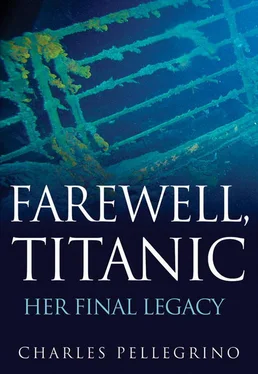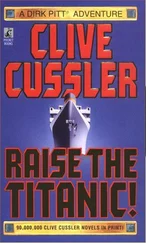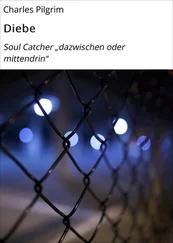By this time, Swedish passenger August Wennerstrom and several of his traveling companions were finding the jolt that bounced them awake in the bow section more amusing than dangerous. They ran all the way back to the third-class smoking room, located just under the after-bridge, where Quartermaster Rowe remained at his post awaiting instructions from the bridge. Wennerstrom and his friends had hoped to find something to drink, to celebrate the exciting “talk of an iceberg,” the stopping of the ship, and what was sure to be an extra day or two of better than average accommodations and all the free food one could eat.
Finding the smoking room’s beer service closed down for the night, and with little else to do except wait and see if the Titanic ’s engines were going to start up again, they lit cigarettes and played the piano. Even witnessing a group of Italian immigrants entering the room with life jackets and uttering prayers to Maria failed to darken their spirits. The Swedes sang louder and started dancing in a circle around the distressed Italians.
Far in front of the party in the smoking room, just a few steps to the rear of the spiral stairs on G deck, twenty-one-year-old Daniel Buckley had jumped out of his lower bunk the moment he felt the crash. Even as Quartermaster Olliver saw the helm reverse and the iceberg pass astern, water began running over Buckley’s shoes. Colder than the steel deck plates, foot-cramping cold, the water was trying to rise against bed frames and cabin walls.
“You’d better get up,” Buckley told his three cabinmates. “There’s something wrong.”
They had all been awakened by the collision, but they had all come aboard with total confidence in the world’s largest new steamer, regarded by the press and by Edwardian culture to be the virtually unsinkable pinnacle of technology’s achievements. Buckley’s bunkmates merely laughed at him.
“Get back into bed,” one of them taunted. “You are not in Ireland anymore.”
Buckley put on some warm clothing and ran up, in his wet shoes, from G deck to the forwardmost of the ship’s two well decks. He arrived not very far from the place where Joseph Scarrott had stood alone atop the forecastle, watching the Titanic come slowly to a stop after skirting what appeared to be a second iceberg. There were more people arriving on deck now, more and more of them. Few seemed to be taking the several tons of ice on the well deck very seriously. The icefall had occurred on what was normally an outdoor recreation area for the steerage passengers, and many of Buckley’s fellow travelers were launching themselves into impromptu games of ice hockey and not-so-playful ice-ball fights.
Buckley’s mind was working on an altogether different assessment of danger, and it occurred to him that life jackets might soon be needed on the playground, so he decided to head down again to G deck, where he knew he could count on coming back with at least four life jackets from his cabin. At the bottom of the stairs he encountered an unexpected barrier. The water had swallowed the stairs at least four steps deep and was lapping toward his feet as he watched. The four life jackets—along with everything Buckley owned that was not presently in his pockets—were already disappearing into the Atlantic.
In the next compartment forward, lamp trimmer Samuel Hemming discovered equally disturbing signatures of disaster. Although he was not quite ready to believe in signs that were plainly readable, he knew better than most people exactly what was occurring. More than four hours earlier, as he was leaving the bridge for some much-needed sleep, First Officer Murdoch had told him, “When you go forward, get the fore scuttle hatch closed.” Hemming looked ahead, toward the hatch between the anchor chains. “There should be no glow coming from that,” Murdoch explained, “as we are in the vicinity of ice, and I want everything dark before the bridge.”
Hemming had closed the hatch himself before retiring to his bunk, but a burst of air pressure from below had blown it open again, at essentially the same moment the crash woke him. By the time he ran to an open porthole and looked outside, the iceberg had disappeared aft, leaving behind only the loud hissing of escaping air. Hemming traced the source of the hiss to the bottom of the forecastle head, in the storeroom compartment nearest the point of the bow, immediately in front of the double-hulled sides of the locker where the anchor chains were stored. In this region of the ship, every hull section was doubly layered, from the very bottom all the way up the sides—yet underfoot, water was flooding into the tank space above the keel. Air was shooting out of the tank compartment as though through a high-pressure exhaust line. Lamp trimmer Hemming was now witness to the foremost damage caused by the collision.
By 11:50, ten minutes after impact, a carpenter came down to join Hemming. The lamp trimmer explained his findings: water seemed to be moving up from below, but he believed the ship to have survived in reasonably okay condition, because the anchor-chain locker and the front storage room appeared to be dry.
“No, it’s far from okay,” the carpenter replied. “She is taking water fast in cargo holds [number] 1 and 2 and all the way past the racquet court.” He explained that the flooding was occurring as far back as boiler room number 6.
“What does this mean?” Hemming asked.
A boatswain climbed down behind the carpenter and explained exactly what it meant: “You’d better turn out [scramble out of here]. Anyone in this part of the ship has a half hour to live—the rest, not very much longer.” The boatswain added that this assessment came from Thomas Andrews, the ship’s designer. “But don’t tell anyone,” the boatswain commanded, adding that the designer and the skipper did not want panic to spread, creating the sort of rush on lifeboats that could easily kill everyone. “And so,” the boatswain advised, “let’s keep it to ourselves.”
As the clock struck midnight, John Hardy and at least two other second-class stewards ran along a wood-paneled corridor, banging desperately on doors. Madeline Mellinger, the thirteen-year-old girl whose father had disappeared in New Zealand, was jolted awake a second time by an unexpected commotion—and by the deck steward’s unusually high-pitched cry of “Get up! Put on warm clothes and hurry on deck with life jackets.” Madeline jumped down from the top bunk and ran to the door, but by then the man had disappeared, and it was too late to ask what he was screaming about.
In later years, Madeline would realize that if she had failed to take the man’s order seriously, or if the Colgates had left her behind in boarding school, she would have become motherless as well as fatherless, because her mother was all but completely deaf and did not hear the knock at the door. Obeying the order, Madeline took the life jackets down from the top of the wardrobe closet, shook her mother awake, and grabbed her hymnal (a going-away gift from her school) and a handful of precious letters. The doll she had hugged every night as she went to sleep was too large to carry with the rest of her load, so she tucked it gently into a storage hammock on the cabin wall.
As the Mellingers made their way toward the top deck and toward what was to become the remarkable journey of boat 14, Madeline did not yet believe that they were leaving their room for the last time, so she barely noticed that her mother was wearing only a nightgown and a heavy fur coat but no shoes. For years to come, she would often express feelings of guilt about her mother’s frozen feet. She also began to feel bad about leaving the doll behind the moment she heard adults speculating that the water beneath the Titanic was more than two miles deep and that sunlight could never reach the bottom. Even when she was in her seventies, Madeline was haunted by thoughts of her childhood companion: images of her lovely doll sitting among silently deteriorating curtains and wall panels, all alone in the night—forever.
Читать дальше











